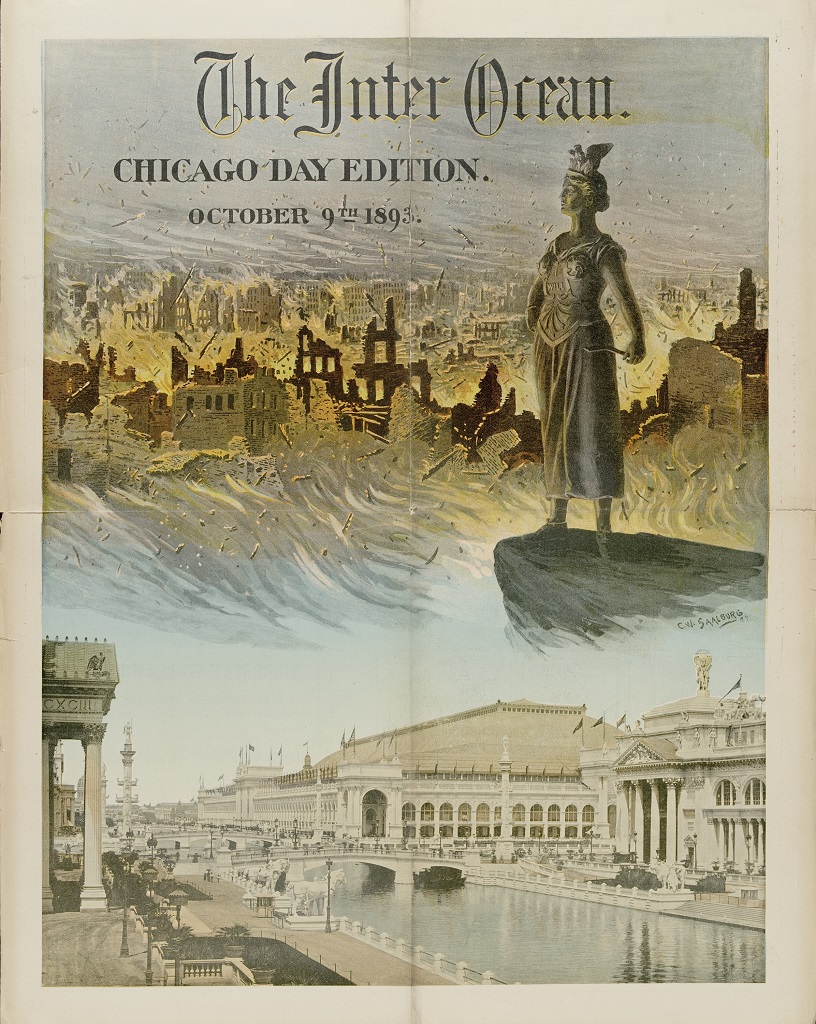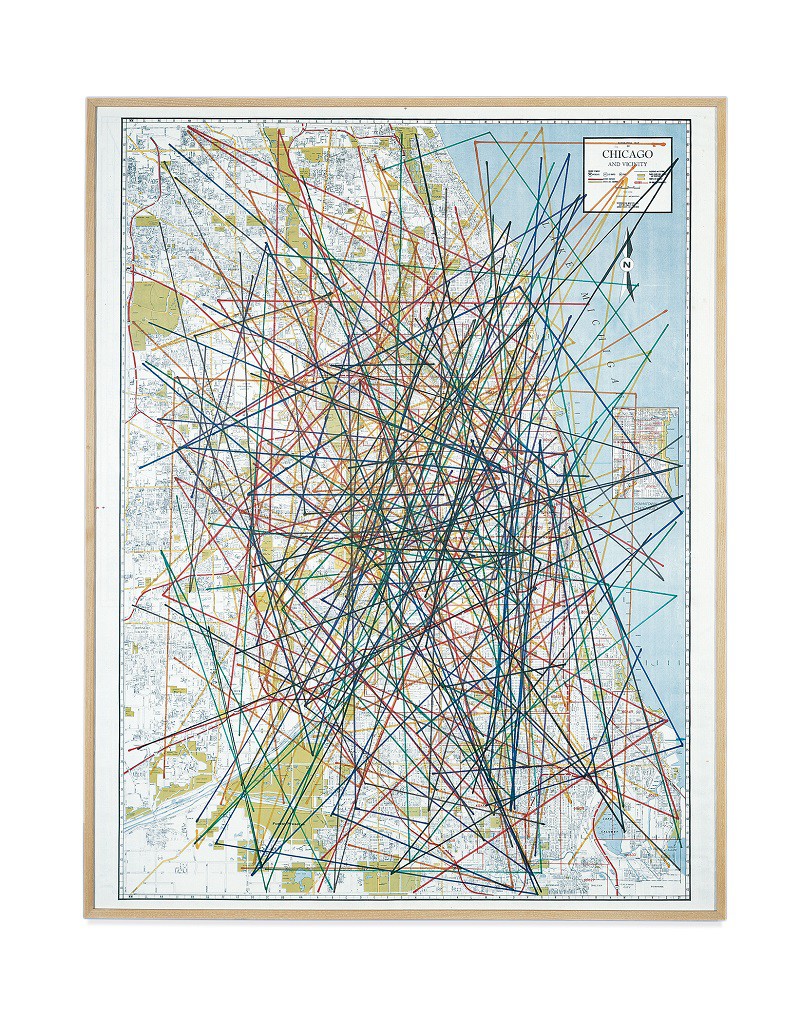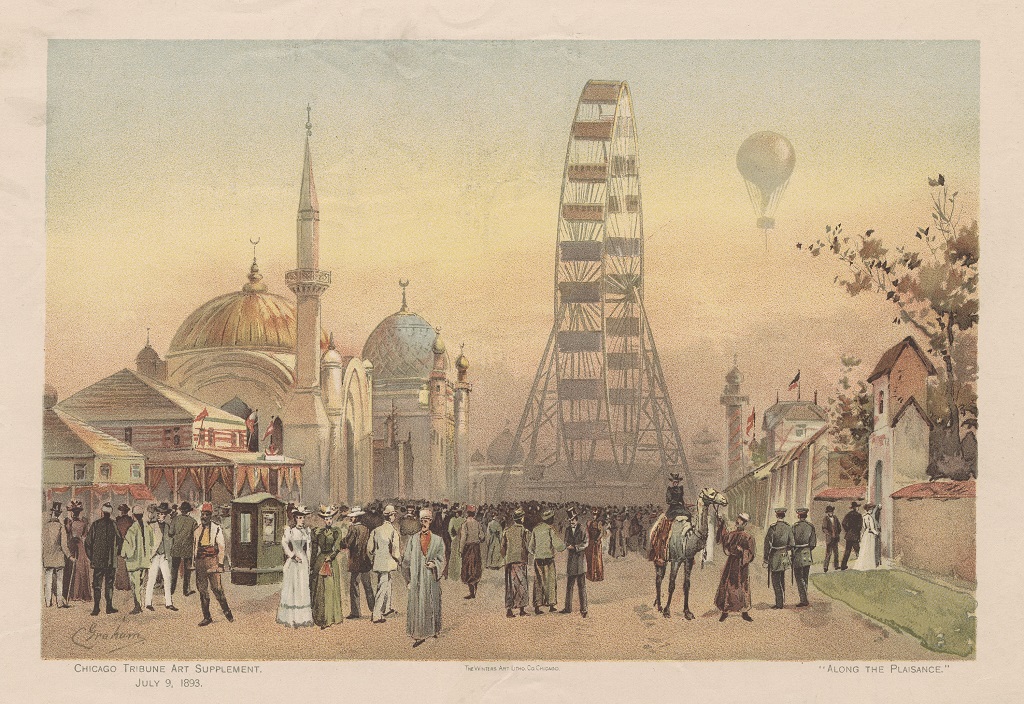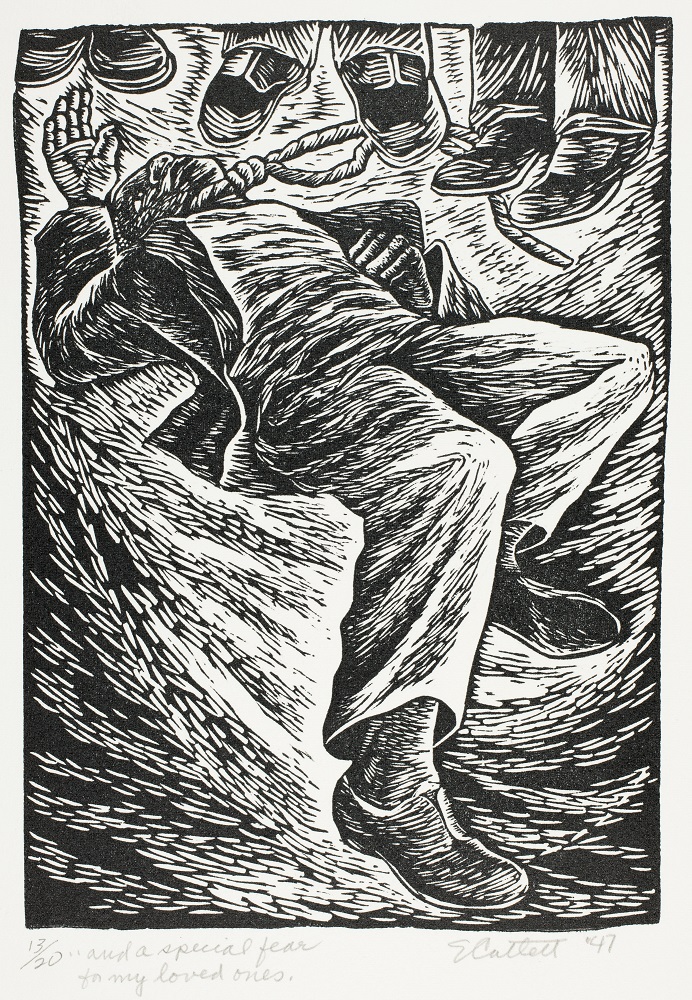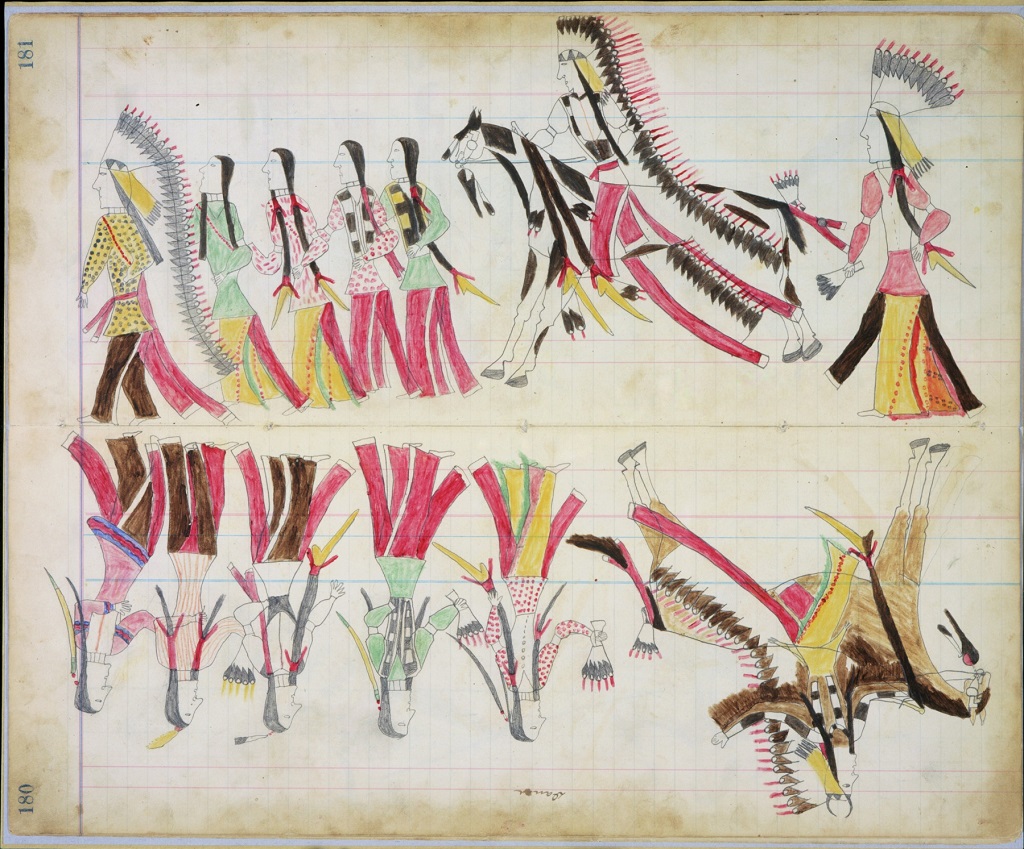Authors:
Megan Clark, Chicago History Museum
Demetra Disotaur, District 65
Shannon Greve,Frank Lloyd Wright Preservation Trust
Jan Kieckhefer, Frank Lloyd Wright Preservation Trust
Colleen McGinley, Dewey Academy of Fine Arts
Heidi Moisan, Chicago History Museum
Sue Stone, Chicago Academy
Summary:
This lesson is built around a cover image from the October 9, 1893 issue of The Inter Ocean, which depicts the Great Chicago Fire of 1871 and the Chicago World’s Fair of 1893. The image is used as a reference point for discussing how a community can be transformed by major events. Students begin by generating definitions of the word “transformation” and giving examples of transformations. They view The Inter Ocean cover illustration and write about how it relates to the idea of transformation. Then they conduct a close reading of the artwork and read an informational text about it. Students use their deeper understanding of The Inter Ocean image to write a few sentences about the transformations shown in the work. Students then identify challenges in their school, neighborhood, or larger community and discuss how these challenges could be transformed in a positive way. Working in small groups, students create posters modeled after The Inter Ocean illustration that depict a current challenge and how it could be transformed. When they present their posters to the class, they explain how the posters show a transformation.
Lesson Overview
Grade Levels: 3–4
Time Needed: 2–3 class periods, 30–40 minutes each
Background Needed
Some background knowledge about the Chicago Fire and the 1893 World’s Fair would be helpful but is not required. These resources can be used to provide useful background information:
- Memories of the Fire that Transformed Chicago
- Art Study: Memories of the Chicago Fire
- The Chicago World’s Fair of 1893: Transforming the World at the Fair
- Art Study: Along the Plaisance
- Art Study: Golden Doorway of the Transportation Building
Essential Questions
- How can a community be transformed by major events?
- How does an artist’s point of view influence the stories of people, places, and events?
Enduring Understandings
- A community can be transformed by tragic events as well as positive ones.
- The Great Chicago Fire of 1871 and the World’s Fair of 1893 were forces of change that affected people locally, nationally, and globally.
Objectives
- Students will read closely to determine what a text says explicitly and to make logical inferences from it.
- Students will cite specific textual evidence when speaking to support conclusions drawn from the text.
- Students will integrate and evaluate content presented in diverse media and formats including visually and quantitatively as well as in words.
Key Vocabulary
- challenge
- 1893 World’s Fair (also called the World’s Columbian Exposition)
- Great Chicago Fire
- lithograph
- phoenix
- point of view
- symbol
- transformation
Standards Connections
Common Core State Standards
Anchor Standards in Reading: http://www.corestandards.org/ELA-Literacy/CCRA/R/
- CCSS-ELA Reading Anchor Standard 1: CCSS.ELA-LITERACY.CCRA.R.1
- CCSS-ELA Reading Anchor Standard 7: ELA-LITERACY.CCRA.R.7
Materials
In the Classroom
- general art supplies, including crayons, markers, and paper suitable for making posters
- a computer with Internet access
- an interactive whiteboard or another classroom projector
Works of Art
- Cover to a supplement to the Inter Ocean for the Chicago Day Edition, October 9, 1893
Other Resources
- Art Study: Cover illustration for The Inter Ocean, Chicago Day Edition, October 9, 1893, Read to Build Knowledge
Lesson Steps
- Activate prior knowledge: Write the word “transformation” on the board. Invite students to share their own definitions of the word, referring to print or online dictionaries if necessary. Ask students to give some examples of transformations that they have experienced.
- Connect the concept with The Inter Ocean cover illustration: Distribute copies of The Inter Ocean cover or project the image on a screen. Ask students to look at the artwork and write 2-3 sentences about how this image relates to the idea of transformation.
- Guide a close looking of The Inter Ocean cover illustration: Use strategic questioning to help students look closely at The Inter Ocean illustration and begin to form their own interpretations about the meaning of the work and the artist’s motivations in creating it. During the discussion, prompt students to cite evidence found within the image. Suggested questions include the following:
- What words do you see in the artwork? What clues do they give us?
- Describe the buildings at the top. Why do you think they look like that?
- Describe the woman on the right side of the image. What do you think she is doing? Why do you think that?
- What do the buildings at the bottom of the image look like? Where can we see buildings similar to this today?
- Imagine you are in the bottom part of the image. What do you think might be inside the buildings?
- How are the top and bottom parts of the image related? How might they show a transformation?
- What title would you give this artwork? Why?
- Share an informational text: Have students read the Art Study: Cover illustration for The Inter Ocean, Read to Build Knowledge. Discuss the text with questions like the following:
- What new information do you have about the image on the cover of The Inter Ocean?
- How does this information change your understanding of the top part of the image? The bottom part? The woman in the middle?
- The bird in the image is called a phoenix. Why did the artist place a phoenix on top of the woman’s head? What does the artist want you to understand?
- Discuss the concept of transformation: Review the class definition you established for the word “transformation.” Have students draw upon their deeper knowledge of the artwork to discuss how Chicago was transformed by the fire in 1871 and by the World’s Fair in 1893. Use questions like the following:
- How did the Great Chicago Fire transform Chicago?
- After the fire, what challenges do you think the people of Chicago had to face? What challenges did the whole city face?
- How do you think the city needed to be transformed after the fire?
- How did the 1893 World’s Fair transform Chicago?
- Have students discuss possible future transformations: Ask students to identify some of the challenges that their school, neighborhood, or larger community is facing right now. Lead a whole-class discussion to generate a list of these challenges. Then, for each challenge, ask students to identify the transformation that they would like to see. For example, if walking safely to school is a challenge, what would the transformation of that problem look like?
- Have students create posters: Divide students into small groups. Each group should choose one of the challenges from the class list and discuss how the issue or situation could be transformed. Then have each group create a poster with two scenes, using The Inter Ocean illustration as a model. One scene should illustrate the challenge that the group selected. The second scene should show how that challenge could be transformed in a positive way. Depending on how your students work in collaborative groups, you can assign specific student roles such as note-taking, designing, drawing and coloring, and presenting.
- Allow time for presenting the posters: Have the groups present their completed posters to the class. Invite each group to share how its poster shows a transformation. Use a few of the close-reading questions used above for The Inter Ocean cover illustration to engage in an abbreviated close reading of each group’s work.
Extension Activities
Design a Symbol: Remind students that the “‘I Will’ Maiden” on The Inter Ocean cover was used as a symbol for Chicago during the 1893 World’s Fair. Help students recall the significance of various details in this symbol:
- The woman is wearing armor, showing that she is ready for battle. She is standing tall, showing that she is fearless and confident. These details show that the city of Chicago is strong and unafraid, and is ready to face difficult challenges.
- The phoenix on her head is a mythological animal that catches fire when it dies. A new phoenix is reborn from the ashes of the old one. This symbolizes the transformation of Chicago. After the fire, a new Chicago was born from the ashes of the old Chicago.
Invite students to design a new symbol for their neighborhood, school, or larger community. First, they should decide what qualities they want to represent: courage? strength? honesty? intelligence? Then they should design a symbol that represents those qualities. They could portray an animal, a person, or an object that has those qualities, and add details that will make those qualities more obvious.
Additional Resources
“The Great Chicago Fire,” Chicago History Museum, accessed September 2, 2014, http://www.chicagohistory.org/history/fire.html.
“The World’s Columbian Exposition,” Chicago History Museum, accessed September 2, 2014, http://www.chicagohistory.org/history/expo.html.

